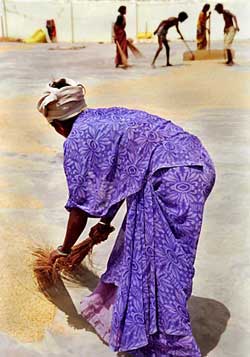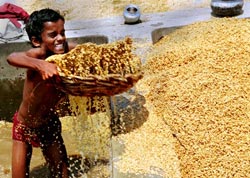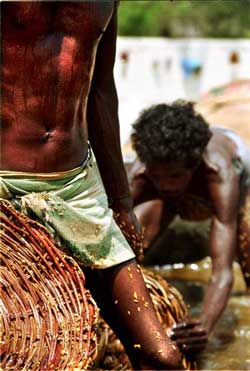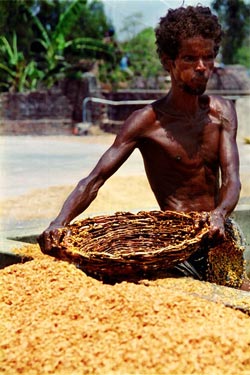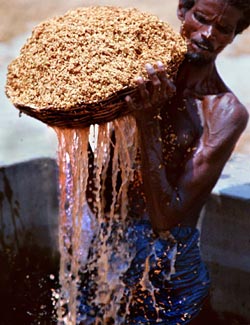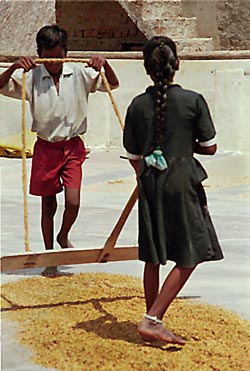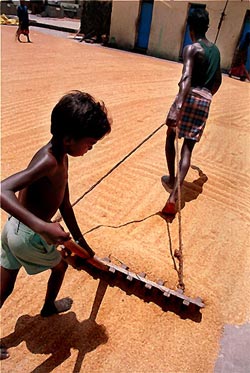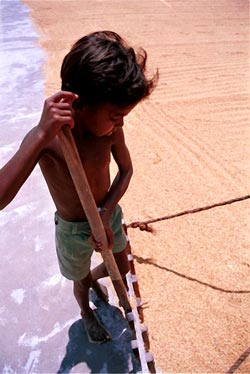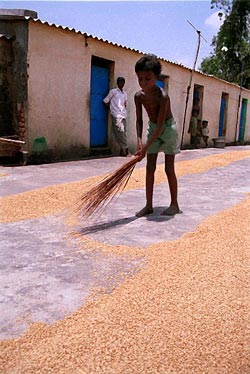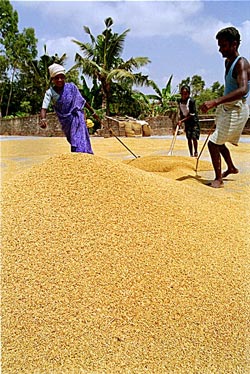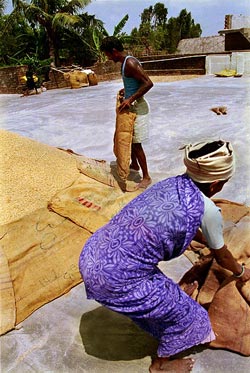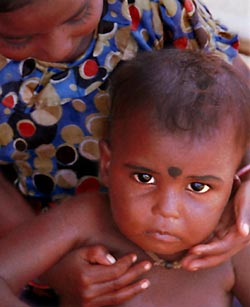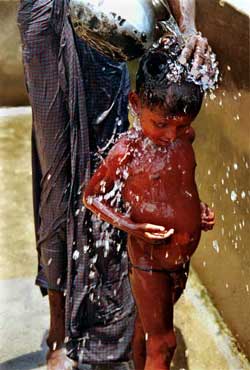|
The
Bondage of Debt: A Photo Essay
By
Shilpi Gupta
The pounding
sun blisters bare dark skin, scorches the ground, and even boils
water—although it is still only spring in Chennai. Its relentless
glare already makes eyes sting, and summer is yet to come.
Sathya, 11, and Manakandan, 12, must toil in the heat of tropical
Tamil Nadu, India, moving across the scalding pavement of "nerkalams,"
or rice drying units, barefoot to help their family prepare rice
for local processing mills. But the ground, layered with the sizzling
grains, no longer fazes them as their feet have already been singed
with calluses.
They are two amongst the thousands of children who slave in Chennai’s
nerkalams from dawn until dusk instead of attending school. Their
parents, bonded laborers, depend on their labor to help pay the
debt incurred to loan sharks.
Debt bondage—when a loan requires a person, family and often
heirs to work for another—has been defined by the United Nations
as a
form of modern
day slavery, a practice internationally outlawed. The Indian central
government has also adamantly outlawed debt servitude, enacting
countless laws and policies to eliminate its existence. But with
the power relegated to the state level, such laws are rarely enforced.
"Slavery-like practices may be clandestine," according
to the United Nations Office of the High Commissioner for Human
Rights’ Fact Sheet on Contemporary Forms of Slavery. "The
problem is compounded by the fact that the victims of slavery-like
abuses are generally from the poorest and most vulnerable social
groups. Fear and the need to survive do not encourage them to speak
out."
Sathya and Manakandan’s parents were not always indebted in
servitude. Vinayagam and Chinnapapa only moved to the Red Hills
on the outskirts of Chennai when, after a poor monsoon season, their
farm in rural Tamil Nadu failed to yield adequate harvests, causing
them to fall into debt and sell their small landholdings. At the
time, Sathya and Manakandan, in the second and third grades, respectively,
excelled at their studies. But during the rainy season, in order
to make ends meet, Vinayagam and Chinnapapa were forced to borrow
money, thus ending their family’s freedom.
The conditions of the loan, which requires the family to work at
the loan shark’s rice mill, offer little hope of release from
the burden of their debt, explained George Heston, a social service
worker with the Chennai based NGO, Jeeva Jyothi. Heston says the
government denies the practice’s continued existence.
Chinnapapa explained through a translator that it usually takes
her family three days to finish 27 bags of rice, working from 4
a.m. to 6 p.m. First, the unprocessed rice soaks in water boiled
under the sun. Vinayagam and Manakandan immerse themselves in the
water to separate the rice with men from three other families living
at the mill. The family then spreads the grains over its allocated
share of space, half the size of a tennis court. As the rice dries,
they sift it thoroughly—both with a rake-like contraption and
by walking across it barefoot, combing through the grains with their
toes—and brush it into neat lines with a straw broom. Finally,
they gather the rice in big piles under burlap sacks to dry further
in the heat of the sun. Then, they repeat the process.
For each bag, the family makes 32 Indian rupees, about 80 cents.
Sixty percent of their income pays the debt, said Chinnapapa. The
lender takes the other 40 percent for the family’s room and
board. Meanwhile, the loan also accrues interest, causing them to
accumulate more debt—creating an endless cycle of bonded servitude.
The children sporadically attended Jeeva Jyothi’s tutorial
courses, and the organization eventually convinced their parents
to send them to school again. In the 1999 edition of its publication,
"A Child’s Voice," Sathya described her excitement
over her father’s permission. "I hope he will not change
his mind after my admission. I will be the happiest person in the
world if I go to school," she wrote.
But her brother, Manakandan, was thought to have more potential
for schooling, and without his hands, Sathya’s labor was indispensable.
Her father was forced to recant.
Families in the Red Hills are not alone in their plight. The United
Nations’ Working Group on Contemporary Forms of Slavery, acknowledging
the difficulty in obtaining reliable data, reported that organizations’
estimates suggest as many as 44 to 100 million persons live in debt
bondage in India alone.
The Universal Declaration of Human Rights and the International
Covenant on Civil and Political Rights maintains, "No one shall
be held in slavery or servitude; slavery and the slave trade shall
be prohibited in all their forms."
Yet this year the International Labor Organization, a subdivision
of the United Nations, documented the progression of bonded labor
in its annual report, titled "Stopping Forced Labor."
In 1978-79, NGOs estimated over 2.6 million bonded laborers in 10
Indian states surveyed. In 1995, the Supreme Court received a report
by the Commission on Bonded Labor in Tamil Nadu estimating 1.25
million bonded laborers in the state of Tamil Nadu alone. Additionally,
some organizations estimated 65 million children are living in a
similar condition.
In a later edition of "A Child’s Voice," Sathya described
her love of drawing, studying, playing and singing. "But I
don’t have time for that," she wrote. "I have to
be with my father and mother to contribute my share of income."
|
